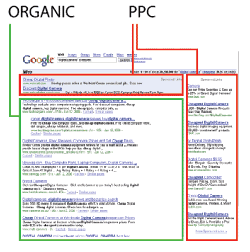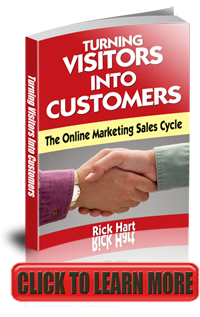Pay Per Click is one type of Search Engine Marketing tactic. With PPC you pay for each click from your ad in the Search Engine Results Page (SERP). This is how Google makes most of it’s money. They call their advertising program AdWords.
Organic Versus Paid Listings

Google Search Engine Results Page
On Google’s SERPs pages there are two types of ad listings. Organic listings appear based on Google’s ranking of a site based on it’s Search Engine Optimization and overall PageRank. These ads appear on the left side of the page.
AdWords listings (PPC) are shown based on how much an advertiser is willing to pay for that keyphrase. The more the bid price the higher the listing.
These listings appear at the very top and to right of the page. The very top listings appear partly because those advertisers have bid the highest click price. But there’s other important factors too.
How AdWords Works
- You choose keywords that you want to bid on.
- You choose the bid price (click price) you want to pay for that keyword.
- Everytime someone clicks on your ad you pay Google that bid price.
- That click is then sent to whatever landing page you choose.
But AdWords Can Be Tricky
Because your ad spend is based on how many times someone clicks on your ad, it’s easy for a campaign to run up costs very quickly. For some very competitive markets clicks cost as much as $20 to $50 apiece. Even less competitive keywords can cost $1 to $2 for each click.
And sometimes a click on a particular keyword does not convert to a sale very well. So weeding out these ineffective keywords is a critical part of managing your campaign. The goal is to find the “buying” keywords that lead directly to a sale.
The Quality Score
Actually a bid price is determined by something called your Quality Score. Your Quality Score is based on a combination of bid price, click through rate, and the quality of your landing page.
To be sure to pay the lowest price for your click you must understand…
- How keywords work so you find the ones in demand and with enough buying intention to lead to a sale
- How to write good ad copy that motivates someone to click
- How to create the best landing page that synchronizes with your keyword and your ad
- How to calculate your Return On Your Investment (ROI) so that you actually make money through your AdWords campaigns.
Without proper skills and monitoring it’s easy to spend hundreds of dollars per day on keywords that don’t translate into sales. This is not something that the average small business owner has the skills or the time to do themselves unless they are willing to learn how it all works.
The Good News
This type of advertising may be the most trackable of any type of marketing. You will be able to know, down to the penny, whether your AdWords Campaign makes money or not. With proper tracking in place, you’re able to identify exactly what keyword phrases are profitable and which ones are not. Once you get the “ducks in a row” you can get new customers for your business in a very cost-effective way. There’s no guessing whether the advertising tactic worked. You can see from the numbers very clearly.
This is far different than typical marketing strategies like newspaper ads, billboards, or direct mail, where you can’t really pinpoint an ads effectiveness or how much you actually paid for a new customer. Knowing your Customer Acquisition Cost is the key to making your marketing dollars effective. With Pay Per Click you can know exactly what works. Now isn’t that a breath of fresh air.



